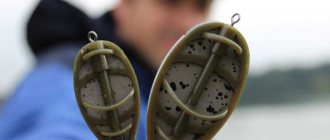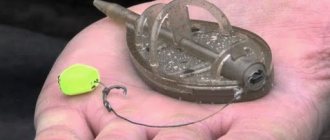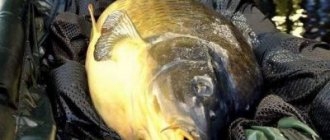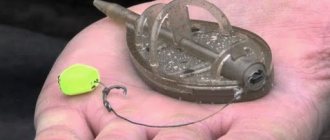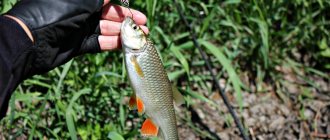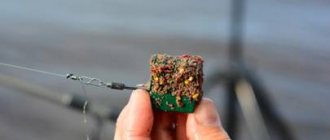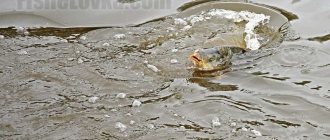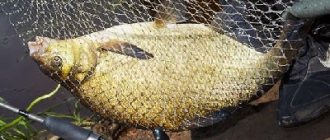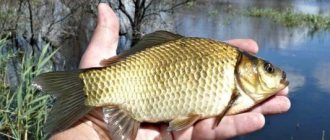The method is not an ordinary open-type feeder with a built-in weight. By and large, this is a small tray with bait laid out on it for carp, bream or other fish, when the baited hook on a small leash is sunk into the food. Fishing with this method has only one drawback - it cannot be used in stagnant ponds, since the bottom in them is often muddy.
Flat method feeder
General information
The method feeder is suitable for catching any white fish. The British were the first to use an open spring with a flat bottom, which was combined with a weight (flat method). The lead plate helps lower the feeder with the base down and the bait up.
Over time, it became clear that open access to food with a hook and attachment located in it has many advantages; this led to the creation of triangular springs, loaded on one side. Due to this, the feeder lowers to the bottom in the only possible position, this makes it possible to install a hook with a nozzle on an accessible part of the equipment.
The bait on the feeder is attached in a special way - at the bottom there is a viscous fraction, on top of which the dusty fraction is molded. The bait is pressed into a mold, making it dense, giving it a finished look.
Lying on the bottom of the pond, the spring is enveloped in a muddy cloud of bait, which attracts white fish of any size, but the hook is equipped with large baits, suitable only for large specimens. Due to its ergonomic shape, the feeder can be thrown over long distances of 50-120 meters.
Installation of the flat method used when fishing for carp
Flat feeder method
The flat-method open feeder was invented after many years of observing underwater inhabitants, in particular after a detailed study of their feeding habits. Today, even a novice fisherman knows that domesticated and wild carp (carp), bream and some of their close relatives consume food by suction. If you lower the underwater camera from the boat and watch the actions of the same bream, you can see how it sucks in everything with its “telescopic” mouth, like a vacuum cleaner, filters and spits out inedible particles. The same thing happens with a flat-method feeder: the fish sucks the food washed out around it until there is a hook in its mouth.
In the classic version, the method type feeder consists of a frame (grid) and a lead weighting agent. Weight varies from 30 to 80 g, which is quite enough for fishing in rivers with moderate currents. Usually, casting a feeder with such a mass does not require a powerful rod, but this is not the case. All elements of the tackle, including the reel and fishing line, must have a certain margin of safety, since this method is used to catch mainly large and strong fish.
The vast majority of feeders of this type are made of plastic, although recently lightweight metal products have also begun to be common. Their upper part is open; there are several characteristic protrusions on it for binding bait.
There are three types of method feeders: for fishing on silted reservoirs, for fishing on a hard bottom, and also for fishing in weak currents or in stagnant ponds and lakes. Models from the first category are distinguished by a shifted center of gravity, due to which they always fall to the bottom surface in the same position. The loaded side is on the bottom, and the groundbait and hook with bait are on top. It's like a tumbler doll. The fisherman need not be afraid of the “burial” of the hook; it always remains on top. At the same time, the flat bottom holds the feeder even on very soft ground and does not allow it to sink into a thick layer of silt.
.IRPP_ruby .ctaButton { background-color: inherit; margin-left: 10px; position: absolute; right: 0; top: 0; } .IRPP_ruby:after { content: ""; display: block; clear: both; }
Differences between the method and other methods of feeder fishing
The method feeder is similar to other methods of catching white fish.
spoon pacifier
Method fishing is very similar to a spoon nipple, which has the same inline equipment, one hook with the possibility of attaching a hair, arcs for fixing bait, but a very heavy base often leads to immersion of this tackle in the muddy bottom; in addition, it is not shipped, but, Accordingly, there is no confidence in oriented descent to the ground.
Pacifier plug
It resembles a banjo feeder. A weight is installed in the eggplant stopper for oriented lowering into the water.
Minuses:
- a patch of food is sometimes covered with turbidity that rises from the bottom;
- the small size of the plug does not make it possible to stuff in a large amount of bait;
- it will not be possible to cast over long distances;
- The small size of the plug does not allow you to camouflage a hook with large bait.
Pacifier plug
Makushatnik
This is a block of top, where the hooks are recessed. Modern methods of using a briquette imply a lead plate on which the briquette is fixed.
Minuses:
- casting over long distances is impossible;
- a homogeneous, non-dusting composition for feeding is sometimes covered with silt from the bottom;
- a heavy plate with a crown can get stuck in muddy soil.
Zhmykhovka (makushatnik)
Groundbait for flat feeder
The bait mixture for flat method fishing should have a slightly higher density and viscosity than for fishing with other feeder feeders. It is important to achieve such a consistency that it does not disintegrate when it hits the water, sinks safely to the bottom, and then gradually falls apart into lumps, creating a compact bait spot at the point.
The ideal bait releases the feeder within 10-15 minutes. The desired viscosity is achieved through proper wetting.
Water should be added little by little and as needed. If there is not enough of it, the mixture will turn out to be too loose, and if it is over-moistened, it will become like clay and will lie in one big lump for a long time, without attracting fish. Since such bait is invisible from a long distance, it does not create either a bait column or a large feeding spot, the bet should be on flavors. With an open type feeder, it is most convenient to use flavoring sprays.
.IRPP_ruby .ctaButton { background-color: inherit; margin-left: 10px; position: absolute; right: 0; top: 0; } .IRPP_ruby:after { content: ""; display: block; clear: both; }
Types of feeders method
The improvement of feeders has given rise to a large number of varieties of feeder gear in design, shape, purpose, and dimensions.
All method feeders can be divided into 3 large groups:
- scoop - semi-closed feeders;
- banjo - small round-shaped feeders that have sides;
- classic method.
Method spiral feeder
Scoop feeders are often used for pellets, but can also be used for standard groundbait. Due to its design, the scoop can deliver bait to any depth without losing it.
Banjo feeders are round in shape, light in weight and small in size. Mainly used when catching cautious fish.
The classic flat method is used most often; these feeders are used when there is active biting. They differ from each other in weight, size, base shape, and number of ribs.
Most feeders are sold as a set with a press - a device for driving bait as tightly as possible. Anglers often call this press a stomp.
Equipment options
If you want to try catching carp using the flat method, then you need to understand how to assemble such equipment. There are two options for equipment:
- Solid installation. Its design is simple. The feeder is fixed on a leash. Thus, it works as a weight that helps the fish to hook itself. With this installation option, it is recommended to use feeders weighing 30 grams or more. Only such a weight can ensure self-hooking of the carp.
- Sliding installation. Another name for this is “inline”. A feeder with a special tube passing through its entire body is used. The fishing line just goes into it. As a result, the flat feeder moves along the line between the stoppers, and the fish does not feel resistance when biting. An excellent option when catching cautious carp and its “brothers”.
Installation of gear can be done in different ways
In addition, you need to know that flat feeders come in different weights and sizes. For example, today you can find “micro flats” on sale with a weight of about 10-15 grams. Such feeders are designed for catching small fish at short distances (15-30 m). Naturally, they are not suitable for carp. Long-range heavy “flat” baits with an increased capacity for bait and a weight of 50-60 grams are much more effective.
Making your own feeder
Fishing using this method allows you to make a homemade feeder feeder with your own hands. The main requirement for them is that the feeders must be within the permissible feeder test, otherwise, when casting over long distances, the fishing rod can be broken.
To make feeder feeders you will need:
- stainless steel wire (the cross-section is selected taking into account the size of the spring);
- a steel pin, with the help of which the feeder is removed from the mold and a hole is formed;
- mold for making a lead base (bar, plaster);
- silicone tube (protects the fishing line).
Having placed the pre-bent wire and pin in the mold, they are filled with lead. Then, when the workpiece has cooled, it is removed from the mold, the pin is removed and a silicone tube is glued in its place. You need to either first find out exactly the weight of the wire and lead base, or weigh the already made feeder - this will avoid breakage of the feeder.
Homemade method feeders for feeders with your own hands from improvised means:
Advantages
There has been talk about this equipment relatively recently; of the existing installations, the “paternoster” and its subtypes are most often praised due to their reliability, practicality and ease of assembly. For almost every feeder fishing condition, fishermen invented their own options, including “helicopter”, “inline”, “asymmetrical”, “symmetrical loop”, “sport”. This equipment is often called the “inline method” due to its similarity to in-line operation.
The “winged” feed tank and three petals are stabilizers that improve the aerodynamics of the product.
They began to talk about the “method” due to its main advantages, tested in practice:
- ease of assembly and installation (replacement) on the main line,
- effect of “temporary invisibility”,
- the bait spot forms immediately after the feeder falls to the bottom,
- the equipment performs all its functions on a muddy or heavily overgrown bottom,
- hooks can be hidden in the bait, inside the feed container,
- optimal aerodynamics – the equipment can be easily thrown over long distances,
- Now the fisherman can fill the container with a larger amount of bait compared to other feeder equipment options.
There is only one drawback here, it lies in the inability to fish in medium or strong currents; in the next section we will explain why. The assembly is, indeed, extremely simple; even when installing the “method” to the main line, you can completely abandon the nodal fastenings. From this it turns out that replacing equipment will be just as simple and quick, which is extremely desirable during active biting or sport fishing.
The effect of “temporary invisibility” is achieved by sliding the feeder (it will remain lying) along the thread until the fishing line is stretched to such an extent that the fisherman notices the bite. The principle is brilliant. The fish grabs and pulls without feeling the load.
Types of installation
There are many ways to install a feeder feeder, but not all fixation methods can be used equally effectively for catching trophy fish.
Solid installation
Self-locking installation option. When biting, the fish makes a jerk and, under the weight of the spring, hooks itself. For the base, a fishing line with a cross-section of 0.26-0.30 mm is used, taking into account the weight of the intended prey, we pass it through the body of the spring. Then we knit a small loop at one end using a figure eight knot.
Next, we put the connector through the fishing line and secure the swivel with a noose loop. Then we tighten the connector onto a swivel. Then we tighten the fishing line so that the swivel and connector fit tightly into the body of the feeder. A leash of about 9-15 cm is fixed to the swivel. We step back from the spring about 50 cm and make a figure eight loop, here the swivel is attached using a noose. It will connect the tackle to the main line.
When making gear, many fishermen knit leadcore instead of fishing line - braided line with a lead core. Due to this, the equipment does not twist and turns out to be submerged at the bottom, which does not scare the fish so much.
Installation using the flat method
Inline
A sliding rig is used for catching cautious fish when they are inactive, since carp, bream, and large roach do not need to move the feeder when biting. To knit this equipment, a fishing line of the same cross-section is used as for blind installation, the total length of the equipment is approximately 50 cm.
A swivel is tied to the end of the fishing line, and then the main fishing line is tied to it. Afterwards, a bead is threaded through the second end; its main task is to prevent the knot from hitting the spring. Then we put on the feeder, reinstall the bead and tie the swivel, the bead is selected in such a size that it is tightly on the fishing line.
Next, we tie a leash of about 9-15 cm to the swivel. With this installation, the feeder will move freely along the fishing line.
An example of in-line feeder equipment on a method feeder
Fishing method: rigs, rigs, feeders, bait
Fishing using this method involves using a special open feeder, onto which thick sticky bait is stuck; only one hook is placed. To press the bait, the method uses special molds that compact the bait so that the bait does not fall out of the feeder when falling on the water. Read more about fishing using the method, equipment and bait.
Gear selection
A method fishing rod is an ideal option for catching white fish at any time of the year. But for fishing to be truly effective, you need to choose and equip the fishing rod correctly.
Feeder
Much attention should be paid to choosing a high-quality fishing rod, since it bears the main load when fishing using the method.
Therefore, the feeder must meet the following requirements:
- The length of the fishing rod is at least 2.7 meters. This is the only way to easily throw the bait at the required distance. It is not recommended to buy very long blanks; the maximum size should be up to 3.9 m. It is difficult to catch trophy fish with a long rod, since the larger the lever, the more effort must be applied to the base.
- The rod test depends directly on the weight of the bait put into the feeder. Basically, the weight of feeders is in the range of 30-100 grams, so the casting of the feeder most often has the same characteristics.
- To reduce the load on the fishing rod when casting a heavy feeder, it is advisable to choose a form with a slow action. When fishing for trophy specimens, a slow action is also considered much preferable.
- The material of the rod is also important when fishing with feeders. It is best to buy blanks made of high-modulus graphite; this rod can easily cope with any powerful jerks of the fish. Composite will also be a completely normal option for method fishing.
Coil
For fishing using this method, only spinning reels are used; their size is chosen so that at least 150 meters of fishing line with a cross-section of 0.30 mm can be placed on the spool. The following points must be taken into account when selecting this equipment element:
- A very large gear ratio is not required. 4.5:1 is quite enough.
- The reel must be selected with a baitrunner. This is a prerequisite when fishing using the method.
- The number of bearings that are in the reel is at least 5 pieces.
Hooks, fishing line
Purchasing high-quality hooks, feeders and fishing lines is also an important step when installing a method for a feeder.
The fishing line must meet the following requirements:
- be invisible to fish;
- have high wear resistance, otherwise when knitting sliding installations the fishing line will quickly wear off;
- be strong enough to withstand the resistance of the fish when fishing.
Depending on the fishing conditions, you can use a cord or regular fishing line. The cord makes it possible to more accurately determine the bite, but when fishing on a pond with a rocky bottom, it quickly wears out. The fishing line is cheaper, but with an equal cross-section with the cord, it is inferior to the latter in strength, therefore, if you are fishing for large specimens in a directional manner, then you should choose braided line.
It is worth choosing original hooks for this method. Most companies make special hooks for this fishing method, which are highly durable.
Fishing using the feeder method, what gear is needed, installation of the feeder with a feeder method, bait and casting gear:
Making your own bait for the “Method” feeder.
Despite the fact that there are a huge number of ready-made mixtures on sale, many fishermen prefer to make them themselves.
Below you will find some of the main questions that beginners ask when making their own baits, and the answers to them.
What is the “Mixture Method” and what is it intended for?
“Mixture Method” is a type of bait designed for use as a filler for “Method” feeders and its distinctive feature is the ability to stay firmly on the feeder for a long time. Most often used in still water for carp fishing.
How to mix bait?
Just like any other bait, for other methods of fishing with a feeder. The only thing that distinguishes it from others is its consistency.
What should the consistency be?
There are 3 main ways to achieve the desired density:
Mix the bait with slightly higher humidity (but not too wet), so that when it is kneaded around the feeder, it creates a tight ball so that the fish will have to try hard before it can break it.
Mix the bait somewhat dryly, but so that when compressed it still forms a ball, but when cast, it begins to gradually crumble on its own, forming a mound of bait at the bottom.
Divide the dry mixture into two parts, in a ratio of 1/3 - 2/3. Make most of it wet (as in point 1), the rest as in point (2). Now make a ball of wet bait around the feeder, and create a coating of drier bait on top.
What happens when using the third method? After casting, the drier bait will crumble, attracting passing fish with its scent trail, and the wetter ball will lie in the middle, holding the fish in place.
What can be used to create the mixture?
In fact, the list can be endless. Below are just the most common ingredients:
Can I use live maggots or cut worms?
It is possible, but you must remember that a live maggot will not sit still in the bait, but will try to crawl out of it, which will destroy the ball. But finely chopped worms are quite suitable for adding to the mixture.
Is it possible to add flavorings?
Yes, of course, and their use should be based on the time of year and type of fish. The most popular flavoring for Method mixtures is Liquid Molasess, which is added to the water before adding it to the dry mixture.
How many seeds can I add to the mixture?
Don’t get carried away, because your goal is not to feed all the fish, but to make them take your bait, so add just enough to just keep the fish at the feeder.
What composition do you recommend to start with?
- 4lb Red breadcrumbs
- 2lb Ground trout pellets
- 2 cans sweet corn (ground in a mixer)
- 1 cup corn flakes
- 1 cup baby formula
- 1 package of ground hemp.
- After mixing, you can add some seeds (millet, pearl barley, rolled oats, etc.).
Source: gf-club.net
Do-it-yourself groundbait and bait using the flat method
The bait is made to be very viscous and dense in consistency, but at the same time it must disintegrate at the bottom, otherwise it will be in a lump and will not attract fish. As a guide, she should wash herself out of the feeder after half an hour.
You can achieve the required consistency by adding water to the bait. You shouldn’t immediately moisten all the food; you need to add a little less, so that you can then adjust it on the pond. If fishing is done on a nipple, then the bait should resemble wet clay in its mass. In this case, it is necessary to add flavorings to the food, since this bait is not visually noticeable, because it does not generate dust.
You can buy special bait for the method in the store and add an astringent to it (for example, molasses) or make it yourself.
Molas is a sweet and viscous component for feeder bait, crucian carp really like it
Here are two working recipes:
For the first one you will need:
- cottage cheese – 200 gr;
- white bread – 350 g;
- ground peas – 200 g;
- cake – 200 g;
- hemp oil;
- ground garlic.
Second recipe:
- corn flour – 250 gr;
- crackers - 1 kg;
- ground seeds – 150 g;
- semolina – 350 g;
- dry cream – 25 g;
- bran – 150 g;
- hemp – 150 gr.
You can mix the bait for the method feeder yourself.
When fishing using the method, you don’t need to do a large-scale first feeding; 6-7 casts of the feeder are enough. You need to re-throw it about once every half hour. The bait used is a worm, maggot, bloodworms, corn, peas, boilies, and polystyrene foam.
Fishing on a feeder method - video from the shore of a reservoir:
Fishing with Method
Today, so many different ideas and tactical delights have been invented and developed in carp fishing that for every change in fishing conditions there is already a pre-worked option of action. The main thing is to know them and be able to apply them. This certainly makes fishing more fun and increases interest in it. The fishing pressure that is exerted on reservoirs is growing every year, and more and more people are starting to join the sport of carp fishing - classic carp fishing.
Basically, the vast majority of people prefer bottom fishing. Some fish with a feeder, some with hooks, however, the principle is exactly the same as in carp fishing - fishing from the bottom. Just different means. The feeder method is a very good bridge between conventional bottom fishing and fishing for trophy carp using modern gear.
You are not far from the usual English donkey, but at the same time you are fishing with a hair rig and use all the elements of carp gear. By the way, this method can often help out experienced carp anglers, who for some reason often avoid it, preferring PVA bags.
Flat method or regular method?
First, you need to immediately find out what the difference is between a flat feeder and a regular feeder. A flat is a feeder that has a flat bottom. The sinker is located at the same bottom. It has better aerodynamics and can be cast very far with the proper skill and fishing rod. It flies much better than a PVA bag and is in no way inferior to carp weights.
Another type of feeder is the classic triangular shape, around which you manually sculpt the bait and you get a real bait ball, inside of which the feeder is located. It will no longer fly as far as a flat, but it delivers much more bait to the fishing point. By the way, you fill the flat feeder not by hand, but using a special mold. This allows you to always make the same shaped “candies” and does not get your hands dirty at all.
When choosing which feeder to fish on, be guided by the principle at what distance the fishing will be carried out. If up to 70m you can get by with a classic triangular feeder, if the distance is higher, switch to flat. It is worth noting that a flat feeder can easily be caught at 120 meters and this is not the limit.
What is the advantage of a method feeder over a PVA bag?
You don't need to worry about PVA at all. You don't have to add salt or worry about keeping the bag from dissolving. The feeder always falls in the same position, since on a flat feeder the sinker is located at the bottom, and on a triangular feeder, if you look closely, two faces are thicker and heavier than the third. Therefore, it will also always fall in the same position. A PVA bag can fall any way you want, and even though you place the sinker at the bottom of the bag, the presentation with a method feeder is still more predictable than with a PVA bag.
You can also send much more with a method feeder, especially the regular shape (triangular), than with the largest PVA bag. The method feeder starts working instantly - loose bait is the fastest-acting bait of all. And finally, a method feeder fills up much faster than a separate PVA bag, although you can make several bags in advance to quickly change equipment when recasting.
What rig is used when fishing with a method feeder?
Strictly online. You can use sliding or fixed. Better fixed, as practice shows when fishing using the method, hooking is much better with a fixed inline.
What do you need for method fishing?
If we talk about gear, then you will need one or another type of feeder, but it is better to purchase both types at once with a reserve. You will also need a shock leader, leadcore, soft leader material, stoppers for the nozzle, heat-shrinkable tubing (more on this later), a swivel to connect the leadcore and the leader.
If we talk about bait, then this is the most important trump card of method fishing. You will need not just little bait, but very little. When fishing on a flat, this is generally some kind of minuscule, when fishing on a triangular feeder it is a little more, but still it does not compare with the volumes that carp anglers dump on their fishing trips. The composition of the bait must include:
Bulk bait is the main and mandatory component. It is better to purchase specialized method mixes that have good adhesiveness and were specially designed specifically to form an elastic mixture for tightly clogging the feeder.
Corn and hemp are our everything!
Pellets – Be sure to add small diameter pellets. It will add air to the bait candy and speed up the process of bait disintegration.
As for boilies, you can crumble the boilies used for fishing in the main mixture, but in general, fishing using the method does not involve feeding boilies in the feeder. You can easily get a spod rod and mix a classic spod mix with boilies. Still, fishing using the method is something between a feeder and classic carp fishing.
Fishing tactics
The tactics of fishing using the method differ from catching trophy carp using the usual methods. Carp anglers are used to looking for a point and throwing 10-15kg of spod mix there from the start and waiting for the fish to approach. Then everything develops according to the classic scenario - the equipment is placed on the edge, the fish approaches. The little thing immediately rushes into the thick of the bait, immediately ignoring the lonely bait. A large specimen is cruising in the distance, right where your gear lies. She will eventually bite if she is attracted to your bait.
The feeder method is a different story. It is the small amount of food that plays a role here, because of which competition among the fish takes place. You are not covering a huge space. You place a small portion in the right place (you, of course, carefully look for it with a marker). At the same time, we repeat once again, you can easily feed the point with Spod. It is better to throw bait with a sinker to your ball with a couple of more balls of the same shape.
Fishing using the method, due to its efficiency, involves conducting reconnaissance in force. You can easily search for fish throughout the pond, throwing the bait to different places each time. For example, you explored the bottom and found several promising places. You don’t have a bait spot where the fish should go, you don’t have anything that obliges you to fish only in this place. You can easily set off with your rods for free swimming and, as they say, look for fish. Reconnaissance fishing tactics quite often yield results.
What type of nozzle should I use?
It is best to use small nozzles. Boilies are no more than 10-12mm, although some fish with 14mm, here you should try both before choosing your option. You can also fish with plastic corn. When it comes to floating or sinking baits, the best option is a critically balanced one. When the hook lies deep in the bait, and only the bait is slightly raised and stands out from the general background. The leader material used is only soft and no longer than 8-10cm.
It is best to use a wide gape or curve shank type hook. The size that will work best is around #8. Again, use our recommendations as a starting point, but be sure to try something of your own. Don't be afraid to experiment.
As for heat-shrinkable tubes and rings on the forend, all this can be added, but, as our personal experience shows, the best results were achieved without using any additional accessories at all. Only leader material and hook. All.
How to knead the mix method?
So, the most balanced composition, which we would recommend starting from, is 2 kg of method mix, 500 g of small pellets and the same amount of hemp and corn - per jar.
First you mix the loose mixture. Remember that you add corn and hemp, like pellets, at the end. It is best to mix the bait in 5 stages, pausing for 10-15 minutes. This way, you will allow the mixture to swell well and absorb water. Don’t force things, it’s better to add a little water many times than to pour too much once and ruin everything. It’s good if you have a spare bag of dry mixture, but what if you don’t?
It is very good to soak the pellets in boiling water in advance. Simply pour the pellets you will be using into a bucket and pour boiling water on top. Leave for an hour (the same time that you will be mixing the bait). After an hour, the pellets will be very soft and half-soaked. It will immediately begin releasing nutrients as soon as it enters the water. The best indicator that the dry mixture is ready is when you take it with a dry hand, squeeze it into a ball, and the bait does not remain on your hands and does not stain them. The lump turns out to be quite dense and does not break even if you throw it back into the bucket with bait. This means that the bait has absorbed water, has swollen and is ready to work.
When the bait is ready, be sure to push it through a sieve. This will add air to the bait and help break up the lumps that will certainly form during the swelling and mixing of the bait by hand. As for liquids and attractants, this is welcome, add according to your taste. There are no contraindications. Moreover, remember that you can even pour liquids that dissolve PVA.
Full or partial copying without the consent of the portal editors is prohibited
Recommendations for fishermen
When fishing using this method, beginners should adhere to the following tips from professional fishermen:
- At the beginning of fishing, you need to feed the fishing spot . To do this, you can use a fishing slingshot or a large feeder with a small load.
- Casting accuracy must be high . As when fishing on a feeder with the installation of other rigs, when fishing using the method, the smaller the conditional bait spot where the spring falls, the better. To control the direction of casting, you can use a landmark located on the other side. The clip on the spool will allow you to cast at the same distance.
- During a sluggish bite, constantly re-casting the tackle can only worsen the situation - very heavy tackle makes a loud sound when it hits the water, this will only scare away cautious fish.
- If the biting is inactive, you can correct the situation by adding live ingredients to the food - bloodworms, maggots, and chopped worms are great for this.
- several different flavors in stock .
Basics of feeder fishing - training video:
As you can see, the method has many advantages, but only one drawback. On ponds without a current, the feeder can get stuck in the silt. In other bodies of water, you can effectively catch crucian carp, carp, bream, roach and other white fish using this method.
Bait and bait
The bait is made quite viscous and dense, but at the same time it must disintegrate well on the bottom, otherwise it will lie in a lump on the bottom, not arousing interest. As a guide, the bait should completely empty the feeder after 15 minutes. You can achieve the required viscosity by moistening the bait (if you don’t add enough water, it’s loose; if you overfill, it’s viscous), adding water portionwise.
You should soak all the bait at once, leave a little so that you can adjust it. If you fish with a nipple, then your bait should become a homogeneous mass, with properties reminiscent of wet clay (effective for catching large fish in wild reservoirs where there is a lot of small fish). In this case, do not forget to add flavorings and attractants to the bait, because such bait is visually less noticeable, since it does not generate dust and has a small food stain. Due to the fact that the feeder is open, it is very convenient to use flavoring sprays, especially if you have several types.
You can buy specialized method bait in the store, buy regular bait for white fish and add an adhesive component (for example molasses) or make it yourself. Here are some interesting recipes:
Recipe No. 1
- Pounded wheat bread – 300 grams;
- Cottage cheese 150 grams;
- Cake 150 grams
- Finely ground peas – 150 grams;
- Ground garlic;
- Hemp oil.
Recipe No. 2
- Breadcrumbs - 1000 grams;
- Corn flour 200 grams;
- Semolina 300 grams;
- Ground seeds 100 grams;
- Hemp 100 grams;
- Wheat bran 100 grams;
- Powdered milk 15-20 grams.
When fishing with a rig method, there is no need to do a massive starting feeding; 4-5 casts of the feeder are enough. Re-throw the feeder no more often, once every 15 minutes.
When fishing with a rig method, it is better if you use a large bait: a bunch of worms or maggots, corn, peas, various boilies, “ottomans”, soft pellets. In this case, pellets are often added to the bait itself.
1rubalka.info
It doesn’t matter whether you are a beginner fisherman or a professional - by listening to the tips below and using the right equipment, you can really achieve an unprecedented catch in a few hours of fishing.
The main and most effective difference between the method equipment in the feeder is:
1. Flat base of the feeder. This design is indispensable for fishing on a silted bottom - the feeder does not fall into the silt, in the current or on complex bottom terrain - the feeder does not drag during feeding either due to the current or due to its own weight on steep changes in the bottom (accordingly, the fish are smaller gets scared).
2. The hook with bait is placed directly among the bait mixture, which camouflages the hook as much as possible and greatly increases the likelihood of a bite, especially for fish that feed from the bottom - carp, carp, bream and crucian carp.
The effectiveness and efficiency of method equipment is constantly confirmed at regular competitions, because it is the athletes who use this equipment who, as a rule, take prizes and can boast of large catches. That's why this easy-to-install but effective tackle should be in any angler's arsenal.
Below are tips on using the method from our expert Adam Rooney, sponsored by Guru, Shimano, and DynamiteBaits.
· Make sure that you have selected the right gear for method feeder fishing in these specific conditions. You should have several rods and reels at your disposal for different fishing conditions. For example, for short distance fishing, around 40 yards (36.5 metres), I will use an 11ft Shimano Beastmaster rod, with a Shimano Rarenium C14FA 4000 reel loaded with 6 lb Guructest line.
- I use X-SafeGuruMethod feeders with a 10 cm leader GuruN-Gauge 0.22 (test about 4 kg), QM1 hooks size 14, hair equipment with a fastening ring.
- As you may have noticed, the thickness of my leash is greater than that of the main line. This installation is due to the fact that the leash is quite short and, accordingly, has much less extensibility than the main line, which makes the leash more prone to breaking during a sharp jerk, which are not uncommon when using method gear. Using a stronger leash will allow you to avoid such troubles as the leash breaking.
- Further. When scouting the bottom, I always use a marker weight that is the same weight as the feed-filled method feeder I will be feeding. Thanks to this, the fishing line, after being secured in the clip and the working gear mounted on it, will receive the same load and stretch, which will lead to a more accurate organization of the bait spot in the place you have chosen.
- Try to organize a bait spot as close to the edge or hole as possible. Carp prefer to be in natural recesses, and the closer you organize the table to them, the sooner and more confidently they will begin to try your bait.
- It is critical not to move the feeder once it has reached the bottom. As soon as I cast, I dip the quiver tip and, without touching the reel, watch the line sink.
- After the line sinks, I still leave it loose, since I believe that it is better for the line to spread along the bottom rather than being touched by fish that come to feed.
- From the very beginning of my session, I constantly reposition my tackle. Regardless of whether there was a bite or not. It is very important to me that the approaching fish is guaranteed to be provided with food and does not escape from the bait spot.
- To achieve a sufficient amount of bait on the table, in the first hour I recast every two minutes. Then I start casting every 15 minutes, increasing the interval is necessary to understand the response of the fish. For example, frequent bites signal that the fish eats a lot and confidently sweeps away the bait dose from the feeder in a short period.
- If 10 to 15 minutes pass before the bite, this indicates that the fish is cautious and “shy,” or that there are not many fish on the bait spot and it gets plenty of food. The best tactic in this case is to give the fish a little time so that it has time to get to your baited hook.
·Author: Tim Knight, source
VDR translation
lovimvmeste.ru
Feeder “Method” - installation features for catching carp, crucian carp and other fish
When you are fed up with the usual feeder gear and carp equipment and want to try something new in bottom fishing, you can fish with the feeder method: a universal fishing equipment that combines two directions.
That's why I love carp fishing, it's its versatility. Classic carp fishing based on the catch-and-release principle is carried out using special safe rigs, with a weight and a leash. But there are also deviations from this assembly of equipment. In this article we will talk about one of these options - method fishing, using a special feeder weight.
To many, the described tackle will seem familiar, and there is nothing surprising in this: we have all used a spring feeder at least once. However, the method feeder works more efficiently and is more convenient.
The method feeder is a conventional feeder turned outward. Here the bait is attached to special wings (or petals), forming a lump around the load that attracts carp. The hook does not stick into the food! This is not a hack, use the method correctly!
This gear has some unique features and assembly rules: special plastic feeders (often with offset weights), the use of leadcore/other thick leader as the “base” of installation, the ability to stick a large amount of food (unlike the flat method), fishing as usually with classic carp leashes 15-20 cm long.
There are two ways to assemble a method feeder: “blind” equipment, i.e. The leadcore is fixed inside the feeder, as in in-line weights (the swivel is tightly clamped by the feeder itself; or “slippery” - the weight is not fixed on the leadcore, the neat pulls of the fish are visible better, but self-hooking is impossible.
You can also assemble a more exotic version, which will repeat the helicopter carp installation (the load flies in front, the leash behind it), except for the load: instead of it there is a feeder. But such a layout does not make sense: it is intended for silted areas, and in them the feeding method will go into the silt, and the whole idea of \u200b\u200bthe equipment will be lost.
Carp fishing method
When fishing for carp using the “Method”, the correct selection of bait, finding a good place and a lot of patience play an important role. Having cast the tackle, it is very advisable not to touch the rod at all until the bite, so as not to create vibrations that are transmitted along the fishing line and scare away large fish.
When choosing a casting location, pay attention to the level of activity of the fish in different areas. Throw it where the presence of a large variety of fish is clearly visible. The frequency of recharging the feeder also depends on the degree of activity of the fish.
Large carp pays attention to the smell, the color, and the very content of the bait, so the latter should have a natural color and be very nutritious. You can use corn, worms, boilies and other baits as bait. Using dips when fishing using the method will also not be superfluous.
